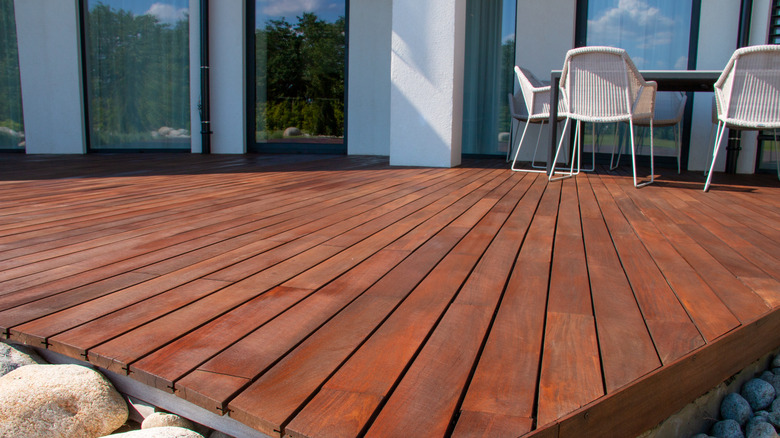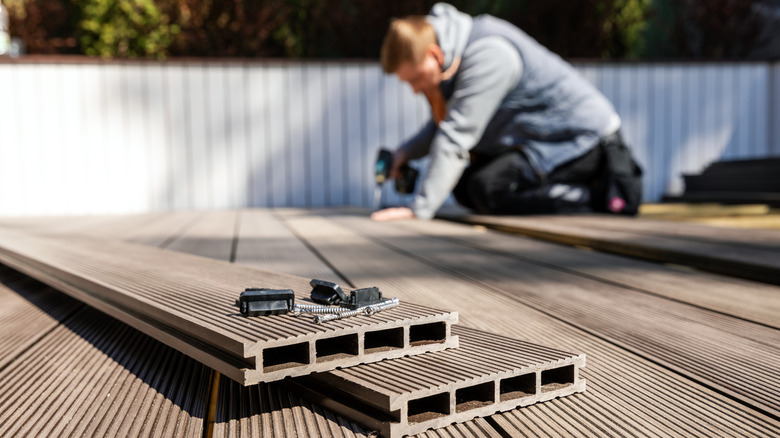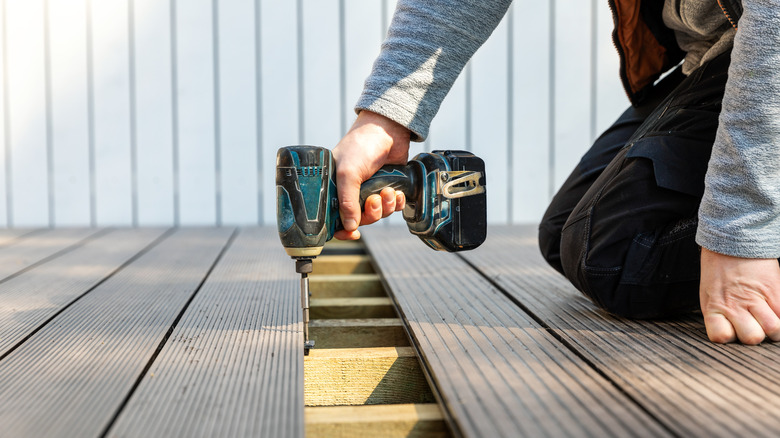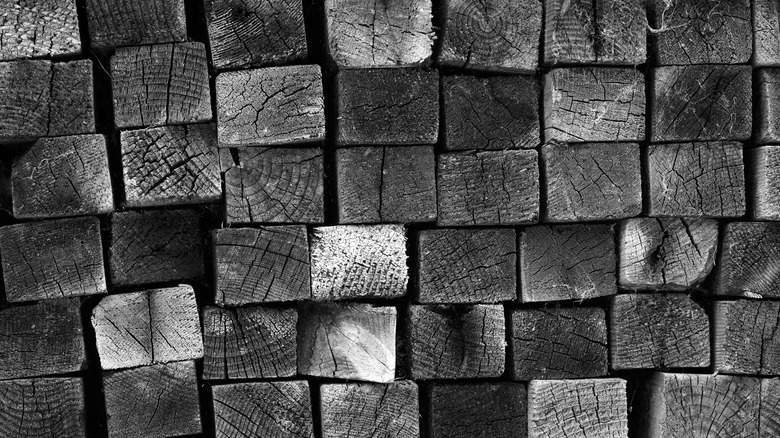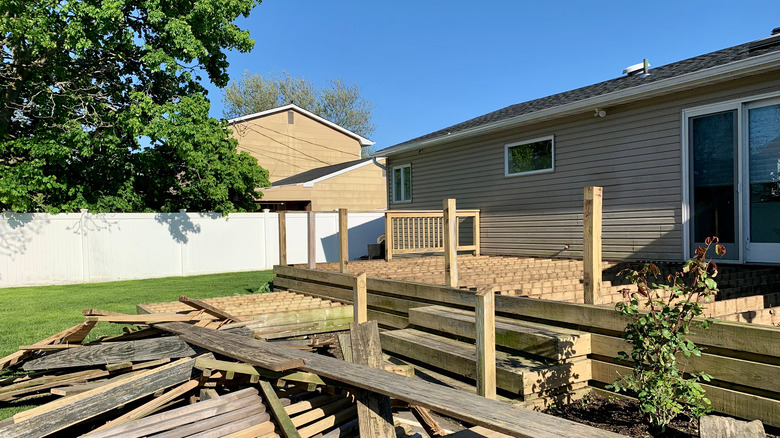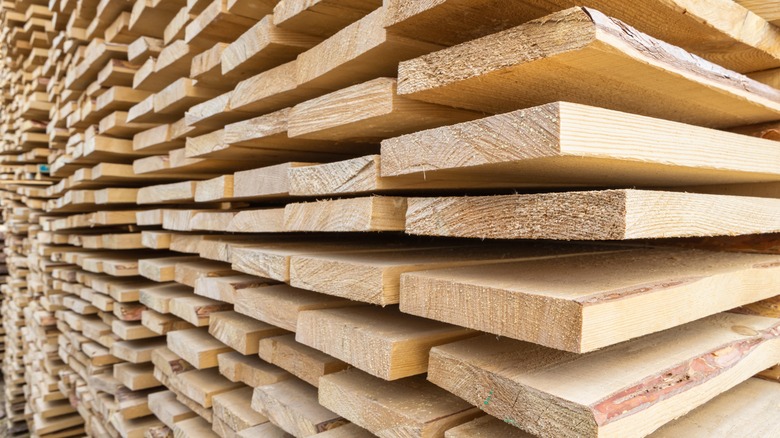5 Clever Tips To Help You Build The Perfect Deck
Many homeowners love the addition of a decking element to their property. Decks add significant value to a home's financial appraisal, with decking being one of the highest ROI options among home improvement projects, according to Zephyr Thomas. Building a deck is a common practice for anyone who enjoys spending time outside, entertaining guests, or anyone who simply lives in a part of the country that sees glorious summer sunshine!
Decking is one of those additions that can, in fact, be accomplished as a DIY project, especially if you are considering building a platform that will lie flush against the ground (rather than an elevated deck to tie in with a raised home footprint). However, the decision to tackle this project on your own or with the help of a professional is something that will be unique to everyone's individual circumstances and comfort level surrounding building and material lifting and power tool use.
One thing that sets a deck apart from other renovations is the unique ways in which you'll use the space. Homeowners often gain a massive aesthetic and spatial addition to the overall property once they've completed a deck installation, but the footprint of a new decking element can vary greatly depending on constraints, needs, and desires. With these five tips in mind, you can build the perfect deck and immediately improve the quality of life and comfort that you enjoy at home.
1. Think about the footprint before beginning any land preparation
The first thing that any homeowner considering a deck installation must do is consult their home's blueprints and property boundary documents. Armadillo Deck reports that a good rule of thumb is to keep any new decking elements to 20% or less than the existing square footage of the home. This gives your home and new deck each the breathing room they need to provide a comfortable and spacious environment for your lifestyle.
In addition to spatial plans, it's important to think about building issues that may arise during the course of land development. A home built on the side of a steep hill, for instance, will need ample foundational structure and heightened beams on one side to support a level platform across the entire span of the new deck. On the other hand, a home may be built on significant amounts of dense bedrock, creating a digging complication that elongates the project timeline and may even require specialized drilling equipment and permits to complete.
Some of these complications can be avoided by placing the deck in a different position alongside the home, while others may demand the help of a specialist. Considering the location, unique circumstances of the project, and more before you buy supplies and break ground is the best way to streamline the deck-building experience and ensure that your new feature will provide everything you expect from it.
2. Purchase more supplies than you think you need
If you are planning to construct the deck on your own, procuring the essential supplies before starting the work is always a good idea. A professional contractor may stockpile lumber and fastening devices (nails, screws, and glues) to make up for any shortfalls in the buying stage of a job, but homeowners often don't have this luxury. This means that any discrepancy that arises between the supplies purchased and the needs throughout the job will result in a stoppage of work while new resources are bought. Similarly, buying in bulk can give you access to great discounts that stopgap purchasing cannot.
Another important consideration to make when engaging in a DIY build is the stoppage time that comes into play each time you have to run to the hardware store to purchase more supplies. For one thing, many homeowners don't own a vehicle large enough to transport significant volumes of lumber. This means renting a truck for the day is a core expense each and every time you have to add to your wood pile. Crafted by the Hunts also reports that nominal size and actual size on boards purchased can vary by a small margin due to planing and drying. Taking this into consideration when purchasing materials is crucial to keeping additional expenses and extra time to completion at a minimum.
3. Use high quality lumber
The quality of the wood used to build a deck can dramatically affect its longevity, beauty, and more. Fantastic Gardeners notes that hardwood decking installations provide unparalleled durability while resisting warping, rotting, and other common issues that present themselves over time with softwood alternatives. As well, hardwoods offer better fire resistance than softer options, providing an ingrained benefit for those looking to place a grill or fire pit on or near the deck.
The wood you select for the project will provide a natural starting point for the visual elements of the decking, too. Not only does your choice dictate how you'll need to care for the organic material that provides so much improvement to your lifestyle, but it also lays the foundation for unique woodgrain, one-of-a-kind knotting, and more. The lines, twists, and minor imperfections that exist within the wood's texture give it character, and with hardwood, you can celebrate the natural aesthetic of the lumber itself.
This isn't to say that softwoods like pine should be avoided. Pine timber is a perfectly wonderful option, but not all boards are created equal. Scouring the pile in your local hardware store for planks that are straight and don't include long twists or knots is essential to creating the best end product possible.
4. Consider the space beneath the boards
Another space that is all too often overlooked in the process of building a deck is the area beneath the boards. A raised deck offers a wonderful lifestyle change for a homeowner, but it also creates the opportunity for immense storage capacity, or an immense growth of weeds, potentially hazardous fungal growth, and a collection of household pests.
Caring for the space under your deck is a crucial step in getting the construction right on this wonderful addition. Simply sliding household items under the deck (with the addition of doors on one or more sections of the siding) often isn't sufficient, however.
Not only should you go about waterproofing and weed-proofing the bare earth beneath the deck for storage purposes, Melfast notes that waterproofing the underside of your decking element is important to maintain the security and integrity of the deck itself, even if you aren't using it for its storage potential.
5. Hide exposed edges for longevity and aesthetic improvement
Wooden edges are a prime target for warping and fraying. The ends of each board provide moisture access into the centers of the wooden material, which can cause severe damage over the long term. This is an issue for all homeowners with decking installations, even those who take incredibly good care of their deck.
Ovaeda notes that there are a number of ways that these exposed edges can be protected beyond the aggressive application of sealers, which won't entirely protect the boards indefinitely. Using a corner trim layout can provide a unique visual element to the boards beneath your feet. This approach requires a bit more preplanning to execute since a portion of the decking area will need to be altered to accommodate the alternative edging.
Another option is to install siding that rises up to meet the decking on top of the otherwise exposed edge. Instead of creating a sort of lip that hands over the side, joining these pieces flush against one another can protect the floorboards with greater precision.
